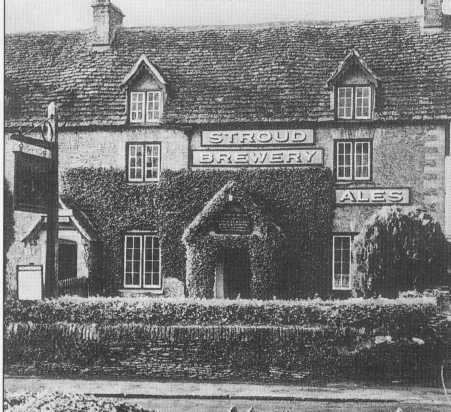Local time Saturday 7:40 PM | ||
 | ||
Weather 12°C, Wind W at 10 km/h, 71% Humidity | ||
Shipton Moyne is a village and civil parish in the Cotswold district, Gloucestershire, England located approximately 105 miles west of London. Its nearest towns are Tetbury (3 miles north), also in Gloucestershire and Malmesbury (3 miles southeast) in Wiltshire. Map. The population taken at the 2011 census was 265.
Contents
- Map of Shipton Moyne Tetbury UK
- History
- The Cat and Custard Pot Public House
- Parish records
- Architecture
- The bells
- The organ
- The clock
- Decorations monuments and tombs
- Pictures
- The Fosse Way
- Local personages
- References
Map of Shipton Moyne, Tetbury, UK
History
The name Shipton, recorded in 1086, indicates the early importance of sheep-farming in the parish economy; the affix Moyne, recorded from 1287, was acquired when the manor was owned by the Moyne family.
British History Online provides a detailed account of the history of the village from the eleventh to the twentieth century.
The Fosse Way forms part of the parish boundary and also the county boundary with Wiltshire. Shipton Moyne was one of several parishes which were transferred from Wiltshire to Gloucestershire in 1930.
The Cat and Custard Pot (Public House)
In 1661 two parishioners were keeping unlicensed alehouses and in 1755 two victualers were licensed. A beerhouse on the west side of the village street was recorded in the early 19th century and was presumably occupied by the beer-retailers listed in the parish later. Apparently still unnamed in 1891, it was called the Estcourt Arms in 1927 but by 1931 the name had been changed to the Cat and Custard Pot.
The village pub's unusual name is said to originate from the book 'Handley Cross or Mr Jorrocks's Hunt' by R S Surtees. The full text of which (including colour prints) may be found here.
"when they reached the meet—the sign of the “Cat and Custard-pot,” on the Muswell Road, they found an immense assemblage"History
The present building erected in 1864 replaced a church with a record going back to Norman times. Part of the North aisle and the porch were preserved and the Eastcourt Chapel on the South side and part of the nave, the central tower being demolished and the nave extended to form an enlarged chancel. A South aisle was constructed with a new tower at the South West corner forming a belfry and entrance.
Alexander Hore - Ruthven, 1st Lord Gowrie and his wife are both buried in St. John the Baptist churchyard. Lord Gowrie was the 20th Governor of South Australia from 15/05/1928 to 26/04/1934. From 15/01/1935 to 23/01/1936 he was the 27th Governor of New South Wales and from 23/01/1936 to 30/01/1945 he was Governor General of Australia. To date the longest-serving governor general. See linked article in Wikipedia.
The list of rectors goes back to 1297e; in the 19th century the church was served by Curates. The former church is recorded in engravings and photographsor. There is an account of the church in the Victoria County History: 'Shipton Moyne: Church', A History of the County of Gloucester: Volume 11: Bisley and Longtree Hundreds (1976), pp. 255–256.
Parish records
The records in 1086 tell us that there were 38 inhabitants, with the population gradually increasing to 90 communicants in 1551, 26 families in 1563, a population of 420 in 1881 and finally of 300 in 1983.
Architecture
T.H. Wyatt (1807-1880) was a cousin of the architects James and Jeffrey Wyatt (and brother of Matthew Digby Wyatt).
T.H. Wyatt was an eminent architect and had a large practice that included work on many Wiltshire churches owing to his patronage by the Beauforts. His design of St. John the Baptist's Church is a good example of a High Victorian design if bearing little relation to its predecessor.
The bells
Five bells were recorded in 1680 and a further bell was added in 1865 - a treble weighing five hundred weight.
One tenor bell was cast in the mid-fifteenth century in London. Weighing fourteen hundred weight it was dedicated to The Virgin Mary.
Two were cast in Bristol by Roger Purden in 1620, on weighing 6cwt. and the other 7cwt.
Two were cast in Gloucester by Abraham Rudhall in 1704, one weighing 8cwt. and the other 10cwt.
In 1962, at the expense of Col. St. George of Hillcourt, two bells were re-cast by John Taylor of Loughborough; the 1620 bell weighing 7cwt. and the 1704 bell weighing 5cwt. All were rehung on a strengthened frame and re-dedicated. The total weight of the bells being some two and a half tons.
There is also a set of hand bells for use on appropriate occasions.
The organ
Built by Broughton and Son of Soho, London and restored by Osmond & Co. of Taunton in 1995, the organ has one manual electrically operated blower. The original handle operated manual blower is still present in the vestry.
The clock
Facing West in the tower, the clock was made by John Smith & Sons of Derby in 1887. It strikes on the hour and half hour. The face was restored in memory of Lt. Cmdr. J.T.B. Birch D.S.O., D.S.C., R.N., a past church warden who for several years gave his time to maintaining the church.
Decorations, monuments and tombs
Pictures
Further pictures of the church, taken by John Wilkes of Cam near Dursley, may be found here
The Fosse Way
The only Roman road in Britain to retain its original Latin name - most others having been renamed by the Saxons - passes through Shipton Moyne. Its route takes it from Exeter (Isca Dumnoniorum) in southwest England, to Lincoln (Lindum) in the East Midlands, via Bath(Aquae Sulis), Cirencester (Corinium) and Leicester (Ratae Coritanorum).
Local personages
Present
Past
